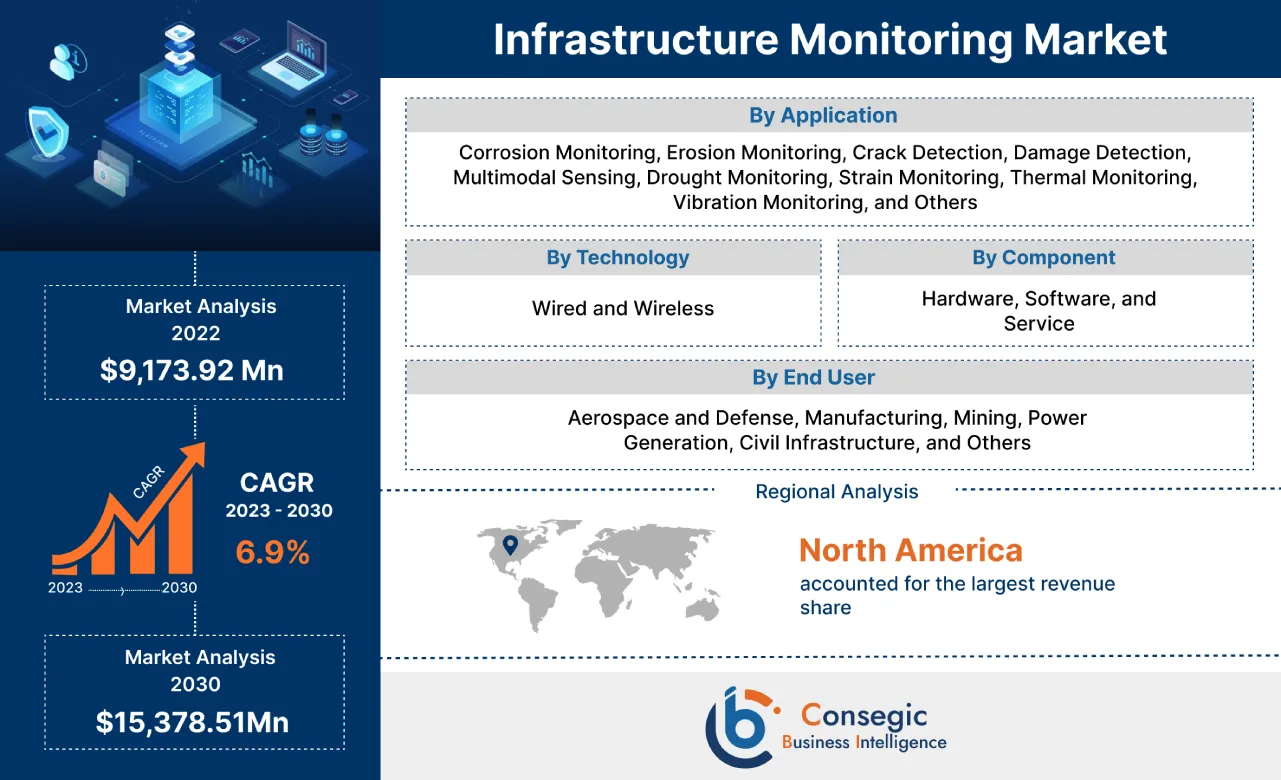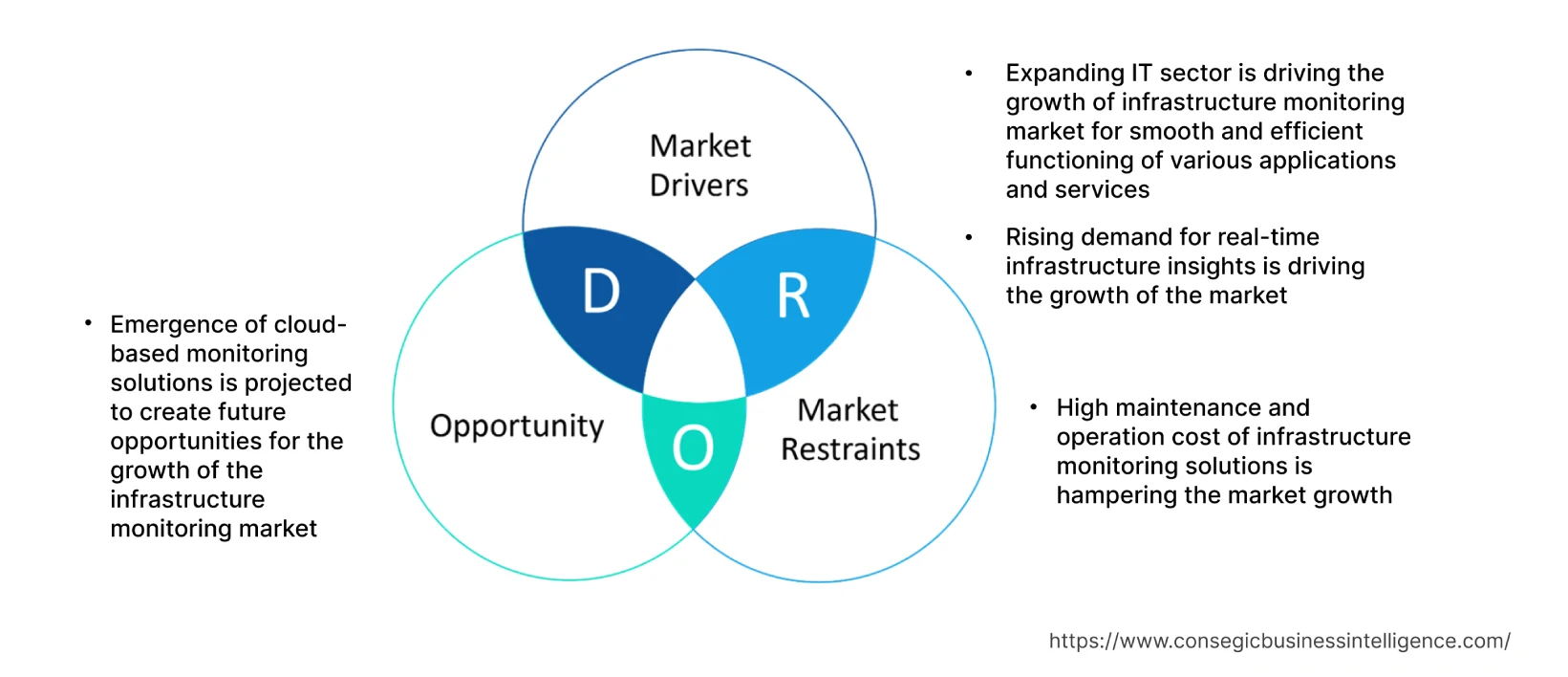- Summary
- Table Of Content
- Methodology
Infrastructure Monitoring Market Size :
Global Infrastructure Monitoring Market size is estimated to reach over USD 15,378.51 Million by 2030 from a value of USD 9,173.92 Million in 2022, growing at a CAGR of 6.9% from 2023 to 2030.
Infrastructure Monitoring Market Scope & Overview:
Infrastructure monitoring refers to the systematic process of observing and tracking the performance, availability, and health of an organization's IT infrastructure including servers, networks, databases, and other critical components. Additionally, the process enables administrators to collect and analyze data, generate real-time alerts, and gain insights into the infrastructure's operational status by employing various monitoring tools and technologies. The proactive approach allows for the early detection of issues, optimization of resource utilization, and timely resolution of problems, ensuring the stability and efficiency of the infrastructure to support smooth business operations.
Infrastructure Monitoring Market Insights :
Key Drivers :
Expanding IT industry
Organizations are adopting complex and diverse technologies to support IT operations including cloud computing, virtualization, containerization, microservices architecture, and IoT devices, among others. The complexity of the environments necessitates sophisticated monitoring solutions to gain comprehensive insights into performance and health, driving the adoption of infrastructure monitoring solutions. The solutions provide the capability to seamlessly scale monitoring solutions, ensuring that the expanding IT infrastructure remains under continuous observation without compromising on performance. Moreover, in a competitive IT landscape, optimal performance is crucial for the seamless operation of businesses. The solutions enable IT teams to identify performance bottlenecks, resource inefficiencies, and other issues that hinder the smooth functioning of critical applications and services. Furthermore, by rectifying the issues promptly, organizations ensure maximum uptime and enhanced end-user experience, hence contributing significantly in fueling the market growth. Analysis of market trends concludes that the expanding IT industry is contributing considerably in accelerating the proliferation of the infrastructure monitoring market. For instance, in June 2022, EcoStruxure IT reforms the complex monitoring and management hybrid IT infrastructure utilizing Schneider Electric monitoring solutions. Schneider Electric provided highly flexible monitoring solutions to maintain the security and resiliency of the infrastructure, reducing the energy consumption and carbon footprint, thus contributing notably in boosting the infrastructure monitoring market demand.
Rising demand for real-time infrastructure insights
Real-time infrastructure monitoring allows organizations to detect and identify issues, minimizing downtime and potential disruptions to business operations. Additionally, downtime is costly for businesses in terms of revenue, productivity, and customer trust. Real-time monitoring enables quick identification of performance bottlenecks and failures, allowing for immediate action to resolve the issues and reduce downtime. Moreover, real-time insights enable IT administrators to identify underutilized resources and potential capacity constraints. Organizations ensure the efficient use of hardware, software, and network resources by optimizing resource allocation, leading to cost savings and improved performance. For instance, in September 2021, the power distribution company in Noida (discom), announced to launch a supervisory control and data acquisition (SCADA) system to enable real-time monitoring of the network. The system is responsible for detecting the exact location of faults, reducing downtime, and increasing network reliability, hence contributing significantly in propelling the market growth.
Key Restraints :
High maintenance and operation
The cost of implementing comprehensive infrastructure monitoring solutions is significantly high which limits small-medium enterprises with limited budgets from adopting such solutions. Additionally, the upfront costs associated with scaling hardware, and additional resources are also high, further restraining the proliferation of the infrastructure monitoring market. Analysis of market trends concludes that the maintenance fees and licensing expenses of the monitoring solutions are also substantially high, ultimately hindering the growth of the global infrastructure monitoring market.
Future Opportunities :
Emergence of cloud-based monitoring solutions is projected to create future opportunities
Cloud-based monitoring solutions offer scalability, allowing organizations to monitor the vast IT infrastructure without the constraints of on-premises hardware. Analysis of market trends concludes that cloud-based monitoring eliminates the need for significant upfront hardware investments and reduces ongoing maintenance costs. Businesses choose subscription-based pricing models, paying only for the resources utilized, thus becoming a cost-effective option, particularly for smaller organizations with budget constraints. Moreover, cloud-based monitoring solutions provide the advantage of remote with an internet connection. The remote access allows IT teams to monitor and manage infrastructure assets across multiple locations, hence emerging as one of many infrastructure monitoring market opportunities that will drive market expansion.
Infrastructure Monitoring Market Report Insights :
| Report Attributes | Report Details |
| Study Timeline | 2017-2030 |
| Market Size in 2030 | USD 15,378.51 Million |
| CAGR (2023-2030) | 6.9% |
| By Component | Hardware, Software, and Service |
| By Technology | Wired and Wireless |
| By Application | Corrosion Monitoring, Erosion Monitoring, Crack Detection, Damage Detection, Multimodal Sensing, Drought Monitoring, Strain Monitoring, Thermal Monitoring, Vibration Monitoring, and Others |
| By End-User | Aerospace and Defense, Manufacturing, Mining, Power Generation, Civil Infrastructure, and Others |
| By Region | North America, Europe, Asia-Pacific, Latin America, and Middle East & Africa |
| Key Players | ABB, Acellent Technologies, Inc., AVT Reliability Ltd., Bridge Diagnostics, Inc. (BDI), Dynatrace LLC, Campbell Scientific, Inc., Digitex Systems, Emerson Electric, General Electric, Honeywell, National Instruments, Parker Hannifin, Rockwell Automation, Siemens AG, Yokogawa Electric Corporation, Schaeffler AG |
Infrastructure Monitoring Market Segmental Analysis :
By Component :
The component segment is trifurcated into hardware, software, and service. The hardware component accounted for the largest market share of 46.7% in 2022 as majority of the organizations rely on legacy systems and on-premises hardware for the IT infrastructure. The systems require hardware-based monitoring solutions to effectively track and manage the performance, thus contributing significantly in driving the proliferation of the hardware segment. Additionally, hardware-based monitoring solutions are perceived as more reliable and robust, especially for critical infrastructure components. Various organizations prefer physical monitoring devices namely network probes and sensors, to ensure continuous monitoring even during network outages. Analysis of market trends concludes that hardware-based monitoring solutions offer a higher degree of customization and control, hence contributing notably in spurring the expansion of the hardware segment.
Services are predicted to witness the fastest CAGR in the infrastructure monitoring market during the forecast period. The growth of the market is attributed to the emergence of advanced managed services that offer improved monitoring solutions and proactive issue resolution, driving the demand for managed services. Additionally, organizations are seeking consulting and professional services to assess the existing monitoring strategies, identify gaps, and implement best practices. Analysis of market trends concludes that the emergence of cloud-based monitoring services offers scalability, accessibility, and the ability to monitor distributed cloud resources is further contributing to market proliferation. For instance, in July 2023, VMware, Inc. introduced advanced cloud monitoring services to easily scale and access the distributed cloud resources. The introduction of advanced cloud-based services offering improved proactive fault resolution is, thus contributing remarkably in bolstering the expansionf of the services segment.
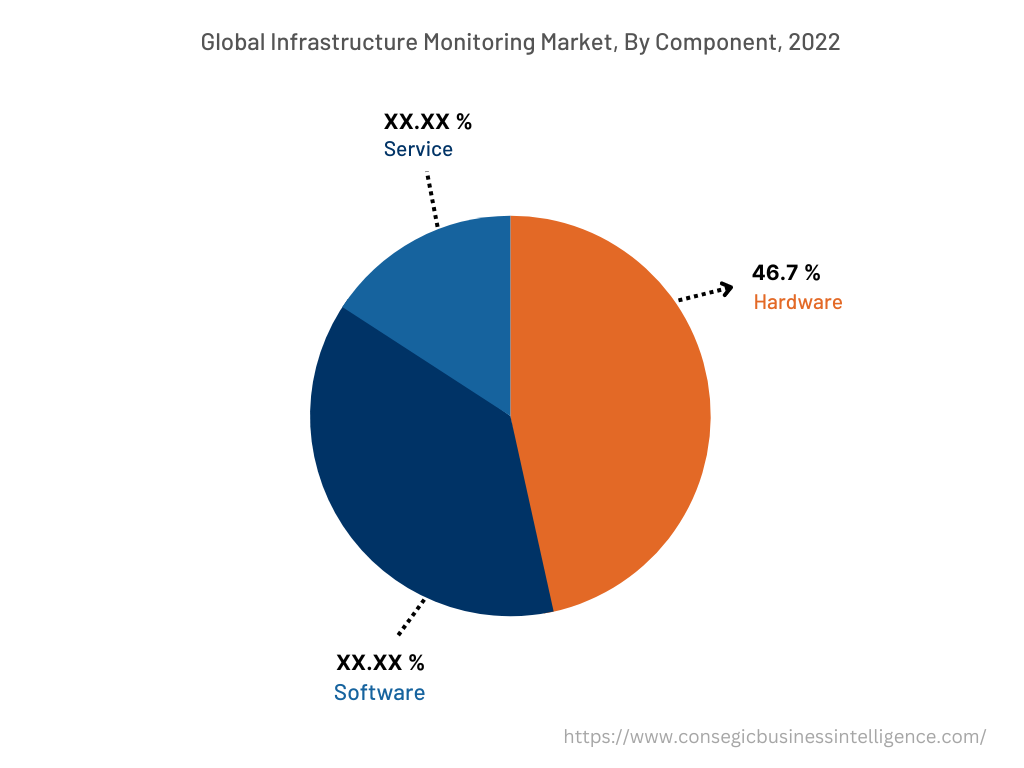
By Technology :
The technology segment is bifurcated into wired and wireless. In 2022, the Wireless segment accounted for the highest infrastructure monitoring market share as wireless systems have lower maintenance costs compared to wired systems. Analysis of market trends concludes that wireless monitoring solutions eliminate the need for periodic cable checks and reduces the risk of cable damage or failure, resulting in cost savings over time. Moreover, wireless monitoring provides real-time data transmission and facilitates remote monitoring capabilities, enabling organizations to monitor from distant locations without being physically present. Furthermore, wireless monitoring solutions consume less energy, reducing the environmental impact and thus becoming a more sustainable option as compared to wired infrastructure. In conclusion, the aforementioned factors are collectively responsible in bolstering the infrastructure monitoring market growth.
By Application :
The application segment is categorized into corrosion monitoring, erosion monitoring, crack detection, damage detection, multimodal sensing, drought monitoring, strain monitoring, thermal monitoring, vibration monitoring, and others. Vibration monitoring accounted for the largest market share in 2022 owing to the increased installation of vibration sensors to detect and analyze vibrations caused by external forces including traffic, wind, or seismic events. The continuous monitoring of vibrations enables engineers to identify potential structural issues, measure the impact of external loads, and ensure the safety and longevity of the infrastructure. Additionally, vibration monitoring is extensively employed in industrial settings to assess the health of machinery and equipment. Sensors are installed on rotating machinery namely motors, pumps, turbines, and compressors to detect abnormal vibrations that indicate misalignment, imbalance, wear, or other mechanical faults. Subsequently, the aforementioned factors are contributing notably in propelling the proliferation of the vibration monitoring segment.
Drought monitoring segment is expected to witness the fastest CAGR in the infrastructure monitoring market during the forecast period. The expansion of the market is attributed to the increasing demand for real-time weather updates from water resources authorities and agriculture industry to monitor and manage drought. Additionally, the increasing occurrence of droughts affects millions of people and causes havoc economic damage, further contributes to the proliferation of the drought monitoring segment. For instance, in August 2022, International Water Management Institute (IWMI) introduced the next generation of South Asia Drought Monitoring System (SADMS) in collaboration with Indian Council of Agricultural Research (ICAR). The system was launched to address the existing challenges of drought management and provide a framework for active drought mitigation methods across South Asia.
By End-User :
The end-user segment is classified into aerospace and defense, manufacturing, mining, power generation, civil infrastructure, and others. Civil infrastructure accounted for the largest market share in 2022 as the monitoring solutions are utilized to assess the health and structural integrity of bridges. Sensors are deployed to monitor parameters including vibrations, strain, deflection, and temperature. Continuous monitoring helps to detect signs of deterioration, settlement, and damage, enabling prompt maintenance and preventing potential accidents. Additionally, the monitoring solutions systems track parameters namely settlement, deformation, and water ingress. Early detection of potential issues allows authorities to take corrective actions to prevent tunnel failures and disruptions. Moreover, sensors are employed to monitor parameters including dam displacement, seepage, and water levels, allowing for timely interventions to prevent catastrophic dam failures. Subsequently, the aforementioned factors are collectively responsible for driving the proliferation of the civil infrastructure segment.
The power generation segment is anticipated to witness the fastest CAGR in the infrastructure monitoring market during the forecast period. The monitoring solutions are used in power plants, including thermal, nuclear, hydroelectric, and renewable energy plants. Sensors monitor equipment namely turbines, generators, and boilers to detect anomalies and predict maintenance needs. Continuous monitoring helps to optimize plant performance, reduce downtime, and enhance operational efficiency. Additionally, the monitoring solutions are also employed in distribution networks to assess the condition of transformers, substations, and distribution lines. Monitoring systems detect voltage fluctuations, line faults, and equipment failures, enabling rapid response and minimizing service disruptions. Analysis of market trends concludes that the increasing number of nuclear power plants is contributing considerably in bolstering the proliferation of the power generation segment. For instance, according to International Atomic Energy Agency, 410 nuclear power plants are in operation worldwide, generating 368,610 megawatts of electricity. In addition, 57 nuclear power reactors are under construction, generating 59,091 megawatts of capacity, thus contributing notably in fueling the market expansion.
By Region :
The regional segment includes North America, Europe, Asia Pacific, Middle East and Africa, and Latin America.
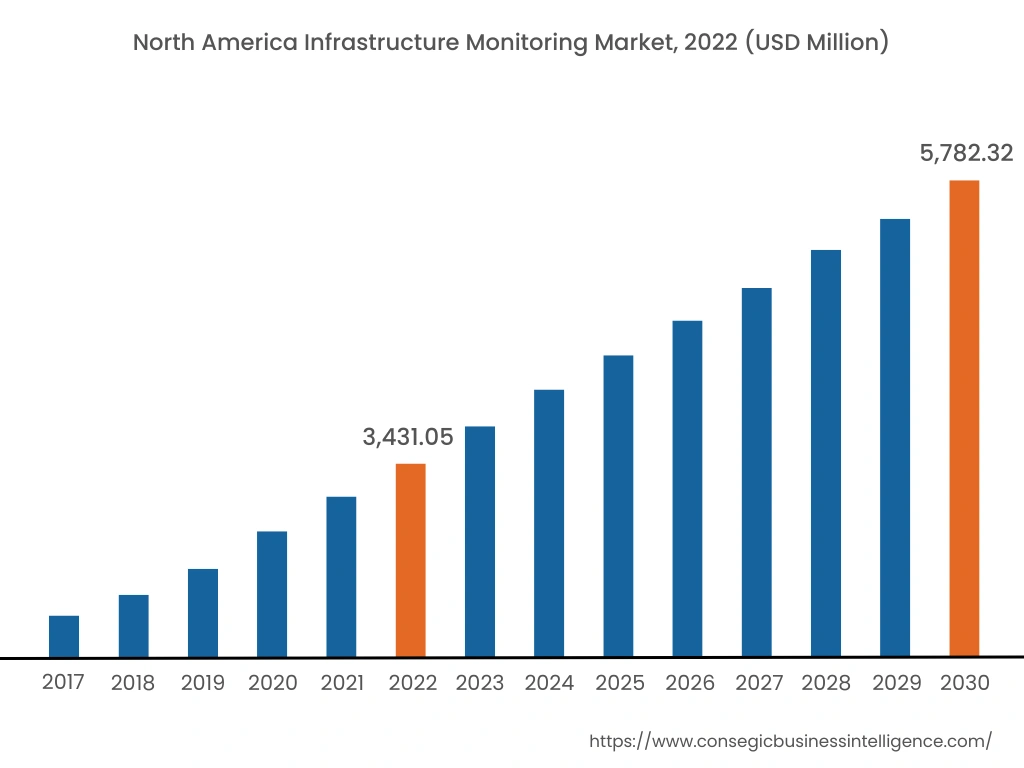
North America accounted for the largest revenue share of USD 3,431.05 million in 2022 and is predicted to reach USD 5,782.32 million in 2030 in the infrastructure monitoring market. In addition, in the region, the U.S. accounted for the maximum revenue share of 57.60% in the year 2022. Analysis of infrastructure monitoring market trends concludes that the growth is attributed to the large and diverse market with a wide range of industries including IT, telecommunications, energy, transportation, and construction. Industries have significant monitoring needs, driving the demand for monitoring solutions. Additionally, the region has a substantial investment in infrastructure development and maintenance. The high investment creates a strong emphasis on ensuring the reliability, safety, and efficiency of critical infrastructure assets, leading to higher adoption of monitoring technologies. Moreover, the region has a robust IT and communication infrastructure that supports the implementation and integration of advanced monitoring systems. The availability of high-speed internet and connectivity enhances the feasibility of real-time monitoring and data analytics, thus contributing significantly in accelerating the market growth in the region.
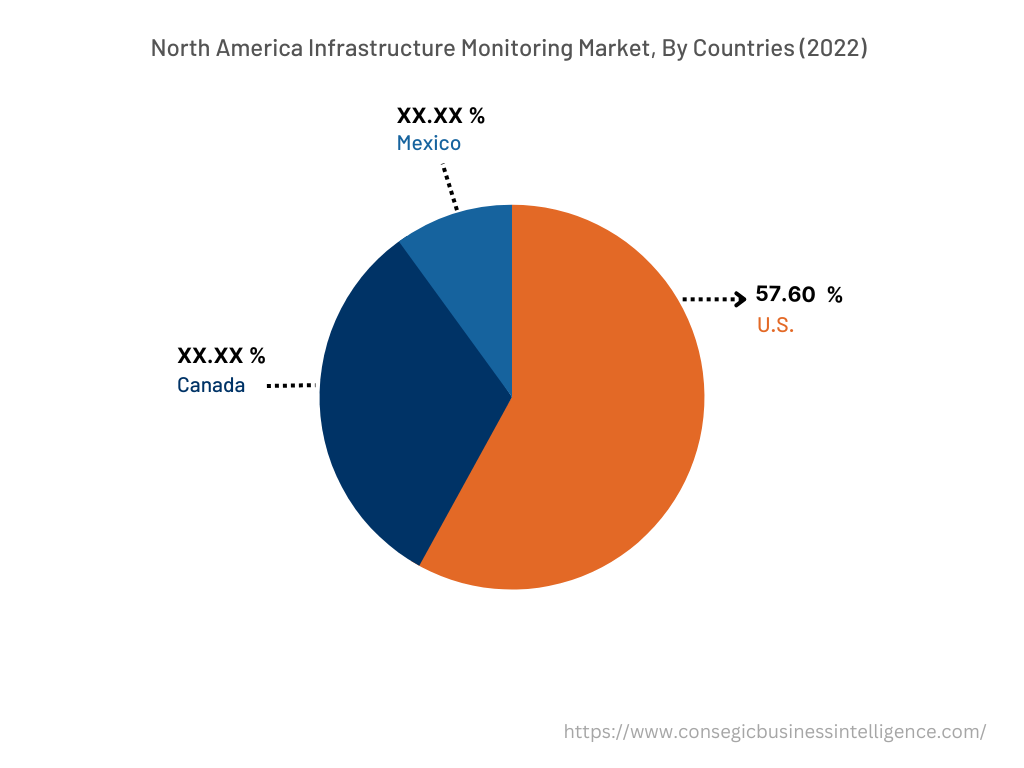
Asia Pacific is expected to register the fastest CAGR of 7.3% in the infrastructure monitoring market. The growth is endorsed by the increasing investment by governments and private enterprises in transportation, energy, and construction projects, driving the demand for monitoring solutions to ensure the safety and efficiency of the developments. The infrastructure monitoring market analysis concluded that the increasing reliance on nuclear plants for the generation of electricity is further contributing to market proliferation. For instance, in April 2023, according to World Nuclear Association, Asia is the major global region with maximum electricity generation through nuclear power plants. Asia encompasses, 140 operable nuclear power reactors and approximately 30-35 nuclear power reactors are under construction, with China leading the position with 55 operable reactors, followed by Japan with 33 operable reactors.
Top Key Players & Market Share Insights:
The landscape of the infrastructure monitoring market is highly competitive and has been examined in the report, along with complete profiles of the major companies operating in the infrastructure monitoring industry. In addition, the surge in innovations, acquisitions, mergers, and partnerships has further accelerated the proliferation of the infrastructure monitoring market. Major players in the market include-
- ABB Ltd.
- Acellent Technologies, Inc.
- National Instruments
- Parker Hannifin
- Rockwell Automation
- Siemens AG
- Yokogawa Electric Corporation
- Schaeffler AG
- AVT Reliability Ltd.
- Bridge Diagnostics, Inc. (BDI)
- Dynatrace LLC
- Campbell Scientific, Inc.
- Digitex Systems
- Emerson Electric
- General Electric
- Honeywell
Recent Industry Developments :
- In September 2022, ABB and Samotics entered a strategic partnership to extend ABB's condition monitoring services to strict and submersible environments.
- In February 2020, Dynatrace LLC introduced the next-generation all-in-one software intelligence platform for structure monitoring. The platform includes enhanced AI and cloud-based dynamic microservices to provide algorithms for improved infrastructure performance and reliability metrics.
Key Questions Answered in the Report
What is infrastructure monitoring? +
Infrastructure monitoring refers to the systematic process of observing and tracking the performance, availability, and health of an organization's IT infrastructure including servers, networks, databases, and other critical components.
What specific segmentation details are covered in the infrastructure monitoring market report, and how is the dominating segment impacting the market growth? +
The hardware component dominates the market as majority of the organizations rely on legacy systems and on-premises hardware for the IT infrastructure. The systems require hardware-based monitoring solutions to effectively track and manage the performance, thus contributing significantly in driving the growth of the hardware segment.
What specific segmentation details are covered in the infrastructure monitoring market report, and how is the fastest segment anticipated to impact the market growth? +
The power generation segment is anticipated to witness the fastest CAGR as infrastructure monitoring sensors monitor equipment namely turbines, generators, and boilers to detect anomalies and predict maintenance needs. Continuous monitoring helps to optimize plant performance, reduce downtime, and enhance operational efficiency.
Which region is anticipated to witness the highest CAGR during the forecast period, 2023-2030? +
Asia Pacific is anticipated to witness the fastest CAGR during the forecast period owing to the increasing investment by governments and private enterprises in transportation, energy, and construction projects, driving the demand for infrastructure monitoring solutions to ensure the safety and efficiency of the developments.
